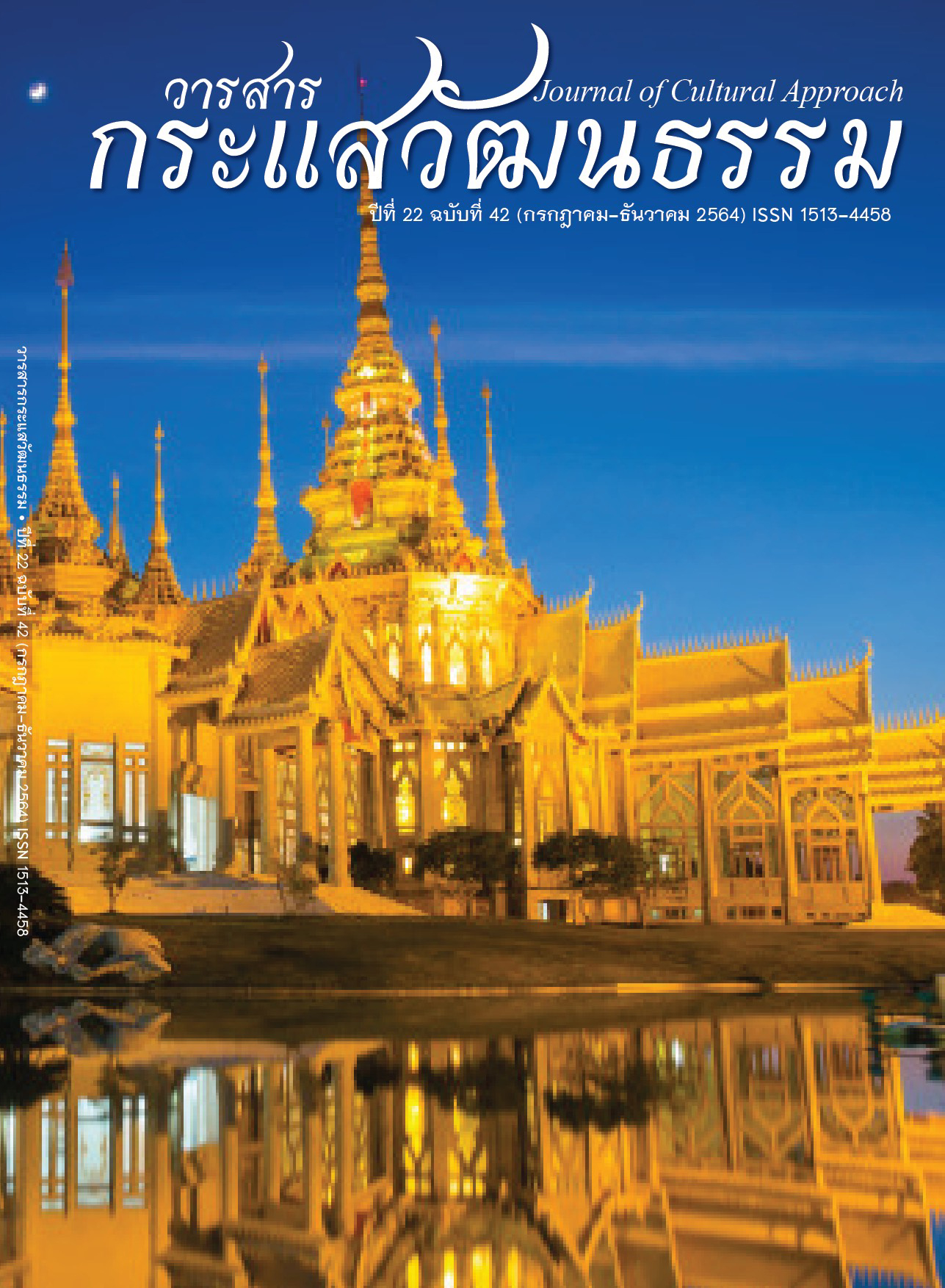Hassadeelink Bird-Shaped Coffins Used for Northern Monks’ Cemetery Ceremony in Lanna Society : Status and Existing Values
Main Article Content
Abstract
The purposes of this study aimed to explain the meaning, roles, and values of Hassadeelink bird-shaped coffins used for the northern monks’ cemetery ceremony in Lanna kingdom. It presented to the Lanna villagers’ beliefs and society. Both literature reviews and the Lanna experiencing experts’ panel discussions on how to invent Hassadeelink bird-shaped coffins were carried out for data summary. The findings of the study revealed that “Hussadeelink bird” had its wing and bird head as well as five elephant-equivalent power found in the Hinmapan forest, resembling its gigantic elephant body. Furthermore, it was believed that Hussadeeling birds belonged to grandeurers In fact, a legend related to “Hussadeelink bird’s beliefs transforming into Hussadeelink bird-styled coffins, which are made of wood covered with other colorful stripped paper. Both dead corpses and coffins are also used for cemetery ceremonies. In conclusion, the presentation for the symbol and values of Hussadeelink bird-shaped coffins found in the Lanna society was divided into four major aspects: 1) Roles in representing authority-symbolized performances and social status; 2) Cultural symbol influencing social cooperation and conservation; 3) Reflections on economic values, and 4) Reflections on atrial and aesthetic values.
Article Details
Proposed Creative Commons Copyright Notices
1. Proposed Policy for Journals That Offer Open Access
Authors who publish with this journal agree to the following terms:
- Authors retain copyright and grant the journal right of first publication with the work simultaneously licensed under a Creative Commons Attribution License that allows others to share the work with an acknowledgement of the work's authorship and initial publication in this journal.
- Authors are able to enter into separate, additional contractual arrangements for the non-exclusive distribution of the journal's published version of the work (e.g., post it to an institutional repository or publish it in a book), with an acknowledgement of its initial publication in this journal.
- Authors are permitted and encouraged to post their work online (e.g., in institutional repositories or on their website) prior to and during the submission process, as it can lead to productive exchanges, as well as earlier and greater citation of published work (See The Effect of Open Access).
Proposed Policy for Journals That Offer Delayed Open Access
Authors who publish with this journal agree to the following terms:
- Authors retain copyright and grant the journal right of first publication, with the work [SPECIFY PERIOD OF TIME] after publication simultaneously licensed under a Creative Commons Attribution License that allows others to share the work with an acknowledgement of the work's authorship and initial publication in this journal.
- Authors are able to enter into separate, additional contractual arrangements for the non-exclusive distribution of the journal's published version of the work (e.g., post it to an institutional repository or publish it in a book), with an acknowledgement of its initial publication in this journal.
- Authors are permitted and encouraged to post their work online (e.g., in institutional repositories or on their website) prior to and during the submission process, as it can lead to productive exchanges, as well as earlier and greater citation of published work (See The Effect of Open Access).
References
Chaikul, W. (2003). Cultural and Social Context of Prasart Sop Making in Chiang Mai Province. Vocational Education. Chiang Mai. Chiang Mai University.
Cittasamyaro, C. (2010). A Study of the Concept of Cultural Belief of Corpse’s Castle Making of Buddhist People in Lanna. Faculty of Arts, Mahachulalongkornrajavidyalaya University.
Jenjai, N. (2012). The Models of Hassadeeling Bird-Invented Castles Found in Chiang Rai Province. School of Social Science, Chiang Rai Rajabhat University.
Ketprom, S. (2001). Traditions of Urban Life. Social Research Institute, Chiang Mai University.
Khemmuk, Y. (2010). Chor and Tung Arts of Faith Local Knowledge. Institute of Language, Arts and Culture, Chiang Mai Rajabhat University and Phra Boromathat Doi Suthep Foundation.
Payomyong, M. (1994). Twelve-Month Tradition of Lanna Thai. Chiang Mai: S.Sub Printing.
Phanichphant, V. (2005). Lanna Culture. Chiang Mai: Silkworm Books’ Publisher.
Rupin, S. (2010). Husadilingu Castle. Journal of Arts Gallery News, 7, 10-11.
Sansa, P. (2013). Lanna World: Development of the Construction of the Funeral Castle, Himmapan Creatures and the Ku. Chiang Mai: Max Printing.
Sikka, P. (2013). Husadilingu. Ubon Ratchathani: Ubon Ratchathani University Press.
Sukkhata, P. (2019). Legendary Opening-meaning ‘Husadilingu Castle’ Funeral of Monks in Lanna-Lan Chang Culture. Retrieved from https://www.matichonweekly.com/column/article_166149.
Thamthi, S. (2007). Lanna Stories Book Set. The Center for the Promotion of Arts and Culture, the Lanna Traditional House Museum, Chiang Mai University.


